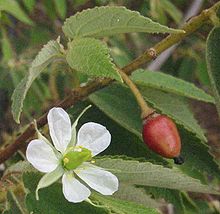- Muntingia
-
Muntingia calabura 
Scientific classification Kingdom: Plantae (unranked): Angiosperms (unranked): Eudicots (unranked): Rosids Order: Malvales Family: Muntingiaceae Genus: Muntingia
L.Species: M. calabura Binomial name Muntingia calabura
L. tree in Hyderabad, India.
tree in Hyderabad, India.
Muntingia calabura, the sole species in the genus Muntingia, is a flowering plant native to southern Mexico, the Caribbean, Central America, and western South America south to Peru and Bolivia. Common names include (English) Jamaican cherry, Panama berry, Singapore cherry, Strawberry tree; (Spanish) bolaina, yamanaza, cacaniqua, capulín blanco, nigua, niguito, memizo or memiso; (Indonesia) kersen; and (Filipino) aratilis, aratiles, manzanitas and sarisa.
 leaves & fruits in Hyderabad, India.
leaves & fruits in Hyderabad, India.
It is a small tree 7-12 meters tall with tiered and slightly drooping branches. It has serrated leaves 2.5-15 cm long and 1-6.5 cm wide. The flowers are small ,white and slightly malodorous. It gives rise to 1-1.5 cm light red fruit. The fruit is edible, sweet and juicy, and contains a large number of tiny (0.5 mm) yellow seeds.
It is a pioneer species that thrives in poor soil, able to tolerate acidic and alkaline conditions and drought. Its seeds are dispersed by birds and fruit bats. It is cultivated for its edible fruit, and has become naturalised in some other parts of the tropics, including southeastern Asia. As a pioneer plant, it could help condition the soil and make it habitable to other plants. However, it might also be considered as an invasive species since it might out-compete indigenous plants.
Contents
Uses
In Mexico, the fruits are eaten and sold in markets. The fruits can be processed into jams and the leaves can be used for making tea. In Brazil, the trees are planted along river banks. The fruits falling from the tree attract fish that are then caught. In the Philippines and Indonesia the fruits are usually eaten mostly by children although they are not sold in the markets.
In traditional medicine, its flowers can be used as an antiseptic and to treat abdominal cramps.
The timber from the Jamaican cherry is reddish-brown. It is compact, durable and lightweight and can be used for carpentry. It could also be used as firewood. The bark can be used to produce ropes and fiber for bark skirts. Due to its ability to grow in poor soil and its effective propagation by means of bats and birds, it could be used for reforestation projects.
In India, it is used in urban gardens for its ability to grow fast and attractiveness to small fruit eating birds such as the flowerpeckers. It is also commonly planted in parking lots.
Habitat
In Malaysia this tree grows very easily and is widespread. With enough sun and water it grows with little or no tending. The Malaysian common name "Ceri Kampung" means "village cherry" in English. In Malaysia, the muntingia tree is found in many urban areas lining the sides of streets in front of row houses. There the muntingia produces great quantities of fruit. Buying the fruit at stores impossible, because people eat the free fruit that grows along the streets. Children climb these trees to pick the fruit and fill tubs for themselves and their family to eat. Fruit from Muntingia is also harvested for export overseas. In nations where the climate is inhospitable to the Muntingia the fruit is considered a luxury and sold at a premium.
Taste
These cherries are very sweet and taste similar to cotton candy.
Growing
This is a fast growing fruit tree. After the flowers are pollinated, there will be lots of the berries growing. Once they ripen, the flowers start to bloom again. After one crop of berries is harvested, the flowers will pollinate back into fruit. The fruit tree will grow for many years.
References and external links
- Germplasm Resources Information Network: Muntingia calabura
- USDA Plants Profile: Muntingia calabura
- Aratiles
- Jamaican Cherry Tree
- Pacific Island Ecosystems: Muntingia calabura
- Claude Lévi-Strauss: The use of wild plants in tropical South America
Gallery
-
flower in Hyderabad, India.
-
Common Emigrant Catopsilia pomona on its flower in Hyderabad, India.
-
trunk in Hyderabad, India.
-
leaves & flowers in Hyderabad, India.
-
leaves & flowers in Hyderabad, India.
-
Common Jay Graphium doson on its flower in Hyderabad, India.
-
Common Jay Graphium doson on its flower in Hyderabad, India.
-
Common Jay Graphium doson in flight on its flower in Hyderabad, India.
Categories:- Malvales
- Trees of Mexico
- Trees of Belize
- Trees of Costa Rica
- Trees of El Salvador
- Trees of Guatemala
- Trees of Honduras
- Trees of Nicaragua
- Trees of Panama
- Trees of the Bahamas
- Trees of Cuba
- Trees of Hispaniola
- Trees of Jamaica
- Trees of Trinidad and Tobago
- Trees of Bolivia
- Trees of Ecuador
- Trees of Peru
Wikimedia Foundation. 2010.









